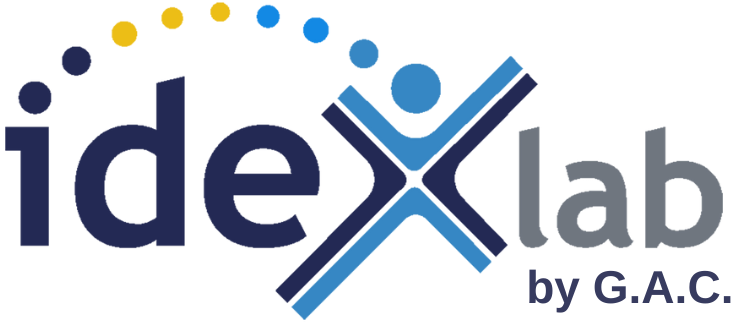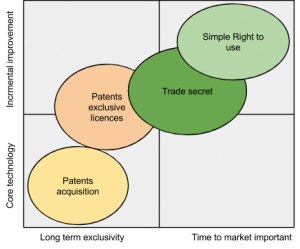Open Innovation and Intellectual Property Rights management have long been presented as contradictory conceptions of innovation.
We discuss here the apparent contradiction around Innovation Property but show that IPRs, well managed, allow to conduct the most effective Open Innovation projects.
* Complementation refers to two organisms having muted on different genes but showing the same caracteristics.Why there is an apparent contradiction in the definitions ?
Between Intellectual property or Innovation Property and Open Innovation the contradiction starts with the definitions. Let’s have a look at what the likes of Wikipedia say.
Intellectual property rights (patents, designs, copyrights) as defined by the WTO are “the rights given to persons over the creations of their minds. They usually give the creator an exclusive right over the use of his/her creation for a certain period of time.”
As one can read, the exclusivity term is of essence here. B.Hall in her study [1] states that: “IPRs are generally designed to exclude others from using a firm’s ideas and inventions”.
Open Innovation on its side defines as follows: “Open innovation is a paradigm that assumes that firms can and should use external ideas as well as internal ideas, and internal and external paths to market”. Alternatively, it is about “innovating with partners by sharing risk and sharing reward.” [Wikipedia, citing Chesbrough].
Here the emphasis obviously is on “sharing”.
Although sharing doesn’t mean giving away, a major rift still lies between ‘exclusive’ versus ‘sharing’, doesn’t it ?
And the contradiction seems to worsen when one looks at the actual practices in both camps.
The growing economical weight of IPRs
While sharing IPRs happens to be true inside some groups having common economical interests or interoperability constraints (e.g. patent pools on video or telecommunications technologies), the general rule remains that IPRs and particularly patents are considered as weapons for protection or attack in industrial conflicts.
Actually [tweetherder]the role of IPRs has become paramount as we have entered into the knowledge economy[/tweetherder]. In a material economy one can protect his assets in a safe whereas in a knowledge economy the only protections are secrets or IPR titles.
As an exemple of this growth we can mention the amount of patents payment that rose from $50B in 1994 to $200B in 2008 (source WIPO and Athreye/Yang in [8]), this does not account for acquisitions like Motorola Mobility by Google ($12B) and Nokia by Microsoft ($7B) which both aimed at filling up their patents portfolio.
The patents promises
We also know from the news some famous war facts such as: Apple suing Samsung and blocking the Galaxy phone sales in the US in 2012. Blogs on the topic flourish of exemple of nonsensical situations in particular related to software or gene patents’ innovation property (see Commodor/XOR patent ).
Invention protection can indeed turn into excessive and questionable practices.
An MIT Sloan article summarizes this nicely and says that [tweetherder]problems happen when “IP is transformed from a means of capturing the value of innovation to an end in itself“[/tweetherder].
When it comes to building new partnerships, this uptight position on IPRs implies strigent rules that put a heavy armor on the shoulders of employees and slows down all projects. Some companies will require an NDA before any discussion can take place, most will want to have a comprehensive contractual agreement before a projet can start and some will simply not talk to others if they don’t own patents.
Let’s discuss a partnership !
Large companies as IBM and P&G however have realized that business agility required a shift in their IP policies and did so in the late 2000s, see [1].
The agility provided by Open Innovation raises new questions
In the Open Innovation camp, stakeholders recommend to use light processes to conduct projects so that information can be shared between innovation seekers and solution providers without unecessary barriers. This is absolutely needed when a company sends a call for ideas in the hope of receiving tens of answers in their selection process. Having NDAs prior to information exchange or keeping innovations secret is not consistent with that plan of course.
Following to these principles, thousands of industrial problems are made public and even more proposals for solutions are shared with the thinest protection of a clic on a web page.
With such a contradiction one can legitimately ask questions.
The seeking company’s main questions usually are:
1. What will happen to my technical challenge? Can’t competitors use it against me ?
2. How can I protect my products against copycats if I don’t fully own the IPs ?
The experts or providing company’s questions are:
3. How can I protect my know-how from being stolen with such a light process ?
4. Am I weakening my position in the long run by sharing or licencing my IPRs ?
Well, as you can guess, as Open Innovation experts we do have the answers :-) and to thank you for reading up to this point I will now give you an overview.
Open Innovation platforms embed the answers
The first question from the seeking company relates to a potential risk in disclosing an industrial problem including to competition. Indeed no one wants that others know the details of our problems, not only in business.
This one is easy to answer, firstly Open Innovation Platforms allow to post questions and challenges anonymously (exemples here). At ideXlab we have developped a workflow that allows seeking companies and solvers to enter into anonymous discussions and negociations until both parties agree to start a collaboration.
Secondly, one shall ask the question of the actual risk if the challenge question is disclosed. In most cases that we have dealt with, the questions asked were related to the improvement of an existing product (so the product and its performances are already known and a disclosure is not a big risk). Others are related to peripheral features of a product so they aren’t in the core activity of the company therefore limiting the risks.
The answer to the second question is slightly more technical. Let’s assume that you have found a technology that you want to incorporate into your next product, there are two options: the technology is either protected by the provider or it is not. If it is protected by a patent or even only a proof of anteriority, then, as part of your agreement you will ask for a right to use (licence), potentially exclusive, or you may acquire the patents. Indeed a right to use does not allow you to sue potential copycats, however a good laywer will have added a commitment by the IPR owner to assist you and prosecute companies who will infrige your exclusive licence. If you want the maximum security, the patent acquisition is the right option.
If the technology was not protected by the provider then it is probably too late to do so and your agreement will include an exclusive licence on the know-how and secrecy will be the rule regarding this unique technology addition !
But before putting a complex legal framework in place one shall consider the actual premium paid to the company getting first on the market for this product or feature ? In many cases, being first makes such a difference that the risk of being copied one year after has little to no importance. Of course this factor varies significantly depending on the market and the products lifecycle.
The third question (provider protection) is one asked very often. On Open Innovation Platforms, solution providers have to disclose some level of information to tease the seeking company without taking too much risk of having the ideas stollen.
Again, we have two situations here.. If the invention is protected then it can be disclosed and the rights on it can be promoted. If it is not, then information exchange shall be conducted with caution. Lawyers and OI intermediaries are used to this tightrope walker exercize and can support you. At ideXlab we put the emphasis on describing the external caracteristics of inventions, as the key performances, instead of disclosing to much about the implementation. After some anonymized Q&As, when the seeker is convinced about the seriouness of the proposal, then he can decide to enter into a confidentiality agreement.
The answer to the fourth question is a matter of both conviction and realism. Technology licencing and integration is a natural flow in a global world. Both parties benefit from the exchange, one with a new revenue streams the other with an improved time to market. As a matter of fact, universities laboratories have a mission to licence their inventions and companies’ labs often work with their IP department to find new ways to market. Still, caution shall be paid on the licencee’s position in the market; restricted fields of applications may be specified in the licences to avoid a potential competition in the inventor own business area.
IPRs and Open Innovation can become the 2 sides of the same coin
Open Innovation and Intellectual Property coincide particularly well when companies realize that they shall capitalize on opportunities rather than only on properties.
And if contradictions exists they are rather in companies’ mindsets than between the actual concepts.
Finally, the exact answers to the parties’ concerns depend on: the nature of the Open Innovation project, the situation of the seeking company on IPRs, the nature of the end product and market, and on the technology provider’s situation.
So the seeking company shall ask itself the following questions first:
– Am I looking for a product core technology, improvements or peripheral functions ?
– What is the added value of the technology for my product and business ?
– Can the provider compete with me on my market at some point ?
– Is time to market more important than long term protection for this product ?
Depending on the answers to these questions there is an Intellectual Property framework that will help put all pieces together, as depicted below.
Exemple of one company IPR options (source ideXlab)
This article is one in our series related to the Open Innovation Practice, we hope you enjoyed it.
References
[1] Open Innovation and Intellectual Property Rights – The Two-edged Sword
https://eml.berkeley.edu/~bhhall/papers/BHH09_IPR_openinnovation.pdf
[2] Does IP Strategy Have to Cripple Open Innovation? https://sloanreview.mit.edu/article/does-ip-strategy-have-to-cripple-open-innovation/
[3] Scenarios for the Future http://www.marcasepatentes.pt/files/collections/pt_PT/1/178/EPO%20Scenarios%20For%20The%20Future.pdf
[4] How intellectual property enables and protects Open Innovation http://www.forbes.com/sites/benkerschberg/2012/04/23/how-intellectual-property-ip-enables-and-protects-open-innovation-platforms/
[5] A practical guide to managing intellectual property rights in an open innovation context https://six6.region-stuttgart.de/sixcms/media.php/1181/Opinet_IPR_Guide.pdf
[6] XOR patent case https://www.google.fr/search?q=CadTrack+xor+patent
[7] Athreye and Yang 2011, Desambodied knowledge flow in the world economy https://www.wipo.int/export/sites/www/econ_stat/en/economics/pdf/wp3.pdf










After all of that, you might want to check out this extremely rare, but real world example of how OI can expose business intelligence that can be used against the seeking firm – https://www.ninesights.com/people/marshallbarnes/blog/2014/06/05/why-i-rejected-a-ninesigma-request-and-will-be-launching-against-the-represented-firms
Hi Marshall,
interesting case indeed, thanks for sharing !
The topics we saw in OI challenges are most of time either improvements to existing products or add-ons.
We rarely see a company submiting a challenge on it’s own core technology.
So exposing to the outside is not a big risk. It’s ok if someone decides to compete on what is not your strategic assets.
And who knows in the end if the technology developped by the expert for his own company will benefit to the seeker or not ?
But still the situation you mentionned could still be a problem for the intermediary and may be they learned from that how to best select the experts to contact… that’s what we beleive we do well at ideXlab.
best,
Pierre